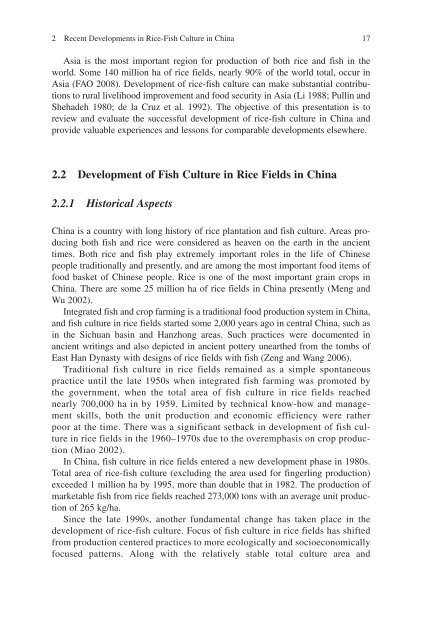Success Stories In Asian Aquaculture - Library - Network of ...
Success Stories In Asian Aquaculture - Library - Network of ...
Success Stories In Asian Aquaculture - Library - Network of ...
- No tags were found...
Create successful ePaper yourself
Turn your PDF publications into a flip-book with our unique Google optimized e-Paper software.
2 Recent Developments in Rice-Fish Culture in China17Asia is the most important region for production <strong>of</strong> both rice and fish in theworld. Some 140 million ha <strong>of</strong> rice fields, nearly 90% <strong>of</strong> the world total, occur inAsia (FAO 2008) . Development <strong>of</strong> rice-fish culture can make substantial contributionsto rural livelihood improvement and food security in Asia (Li 1988 ; Pullin andShehadeh 1980 ; de la Cruz et al. 1992) . The objective <strong>of</strong> this presentation is toreview and evaluate the successful development <strong>of</strong> rice-fish culture in China andprovide valuable experiences and lessons for comparable developments elsewhere.2.2 Development <strong>of</strong> Fish Culture in Rice Fields in China2.2.1 Historical AspectsChina is a country with long history <strong>of</strong> rice plantation and fish culture. Areas producingboth fish and rice were considered as heaven on the earth in the ancienttimes. Both rice and fish play extremely important roles in the life <strong>of</strong> Chinesepeople traditionally and presently, and are among the most important food items <strong>of</strong>food basket <strong>of</strong> Chinese people. Rice is one <strong>of</strong> the most important grain crops inChina. There are some 25 million ha <strong>of</strong> rice fields in China presently (Meng andWu 2002 ).<strong>In</strong>tegrated fish and crop farming is a traditional food production system in China,and fish culture in rice fields started some 2,000 years ago in central China, such asin the Sichuan basin and Hanzhong areas. Such practices were documented inancient writings and also depicted in ancient pottery unearthed from the tombs <strong>of</strong>East Han Dynasty with designs <strong>of</strong> rice fields with fish (Zeng and Wang 2006 ).Traditional fish culture in rice fields remained as a simple spontaneouspractice until the late 1950s when integrated fish farming was promoted bythe government, when the total area <strong>of</strong> fish culture in rice fields reachednearly 700,000 ha in by 1959. Limited by technical know-how and managementskills, both the unit production and economic efficiency were ratherpoor at the time. There was a significant setback in development <strong>of</strong> fish culturein rice fields in the 1960–1970s due to the overemphasis on crop production(Miao 2002) .<strong>In</strong> China, fish culture in rice fields entered a new development phase in 1980s.Total area <strong>of</strong> rice-fish culture (excluding the area used for fingerling production)exceeded 1 million ha by 1995, more than double that in 1982. The production <strong>of</strong>marketable fish from rice fields reached 273,000 tons with an average unit production<strong>of</strong> 265 kg/ha.Since the late 1990s, another fundamental change has taken place in thedevelopment <strong>of</strong> rice-fish culture. Focus <strong>of</strong> fish culture in rice fields has shiftedfrom production centered practices to more ecologically and socioeconomicallyfocused patterns. Along with the relatively stable total culture area and
















